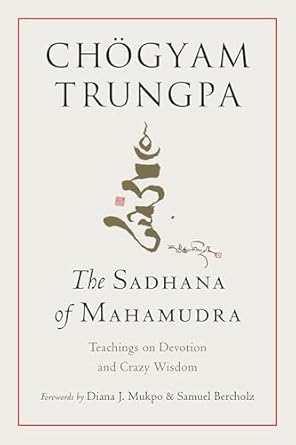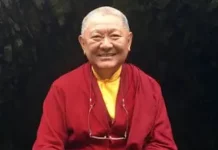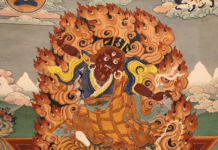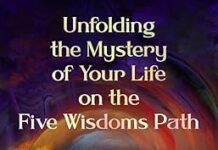
ORDER THE BOOK HERE
“The Age of Reason is over,” a friend told me in India some years ago. Gone are the halcyon days of the Buddha when the search for truth was so compelling, when logic and reason were so powerful, when minds were so open, that the loser of a debate would convert to the faith of the victor.
These are the days when “the three lords of materialism have seized power.” “The most fully developed products” of the Lord of Speech, says Chogyam Trungpa Rinpoche, “are ideologies, the systems of ideas that rationalize, justify and sanctify our lives. Nationalism, communism, existentialism, Christianity, Buddhism – all provide us with identities, rules of action, and interpretations of how and why things happen as they do.” So powerful have these fixed identities become that we can no longer listen to, let alone hear each other.
And lest we think it’s only wacko extremists who have abandoned reason, listen to the climate scientists who despair and feel “hopeless and broken” at humanity’s wanton dismissal of science and evidence. For 35 years the Intergovernmental Panel on Climate Change (IPCC) has issued its reports in what is called “the most important scientific endeavour in human history.” Says one top scientist: “We live in an age of fools.”
I can personally relate to that despair. For 25 years I crunched numbers to produce new measures of progress that go beyond our materialist economic growth measures to include social and ecological realities. I firmly and naively believed that if only policy makers have the right evidence, they will make better policy. Wrong! Policy makers nodded dutifully at the facts and numbers presented, and then carried on business as usual. But I can’t help wonder: Had the IPCC issued its reports at the time of the Buddha in that Age of Reason, would not truth have prevailed, leading to fast, resolute action?
And of course, there is no separation between our own mind and the society we inhabit today. “This is the time of hell on earth. Sadness is always with us and unceasing depression fills our minds…. We are drunk with spiritual pride and seduced by passion…. The materialistic mind dominates everywhere and the mind is intoxicated with worldly concerns….”
Contemplating our own stubborn habits and the state of our world, who cannot relate with these sentiments? And who does not yearn for some way out of the prison in which we are trapped? That’s the bad news. But the good news is that this sadhana is precisely about “quelling the mighty warring of the three lords of materialism.” It’s just that logic and reason alone are inadequate to conquer afflictions of this magnitude and ubiquity. More than ever before, as Carolyn Gimian says in her new introduction to the 2025 edition, The Sadhana of Mahamudra “gives us the juice, the energy, to work with all this insanity we call modern life.” She writes: “We know in our hearts, minds, and bones that we are facing a mega crisis in this era, one that frightens us, divides us, and makes us question whether we and our world are up for it. We need simplicity, we need kindness, we need to slow down and get real. But we also need bravery, we need power, we need ways to shine and influence and conquer, without aggression, while also transcending our cowardice and hesitation. Those abilities are what The Sadhana of Mahamudra and its attendant teachings embody.”
To qualify as “terma” or “treasure teachings,” two basic criteria must be met – one is time-bound and the other is timeless: The teachings must speak to the particular time and culture in which they appear – both in description and in the solution they offer. And they cannot deviate one millimetre from the timeless wisdom of the Buddha. To that end they must be “certified” as terma by a recognized master. That master was Jamyang Khyentse Wangpo in the 19th century and Dilgo Khyentse Rinpoche in the 20th. It was the latter who pronounced the Sadhana of Mahamudra as terma. This sadhana is truly the treasure teaching for our time.
In the sixth talk of his 1975 Sadhana of Mahamudra seminar in Boulder, the Vidyadhara remarked that “people in the future who relate with this particular sadhana” can use it “as inspiration…to wake yourself from deepest of deepest confusion and chaos and self-punishment.”
And so, this new Shambhala Publications edition of The Sadhana of Mahamudra could not be more timely. Not only is the sadhana needed more than ever, but this particular edition is truly historical. For the very first time in the 57 years since the Vidyadhara penned the sadhana, the text itself is being made available to the general public without any restriction. Perhaps this is the time to release the enlightened energy of the sadhana on the world.
As Sam Bercholz, founder of Shambhala Publications, writes in his Foreword to the new edition, he finds the sadhana “more profound than ever, especially given the continuing degeneration of the planet through pollution, climate change, and all those environmental issues, as well as physical, psychological, and spiritual materialism being ever more rampant.”
While this new edition still contains the edited talks of the Vidyadhara’s two 1975 Sadhana of Mahamudra seminars, previously published as the book Devotion and Crazy Wisdom, students can now also watch the videos and listen to the audios of those talks on the Chogyam Trungpa Digital Library. As the Vidyadhara says in the last talk of the Boulder seminar, “the sadhana can be discussed much deeper and further” than he has done in these seminars. And so, one can never get enough of studying and practising this sadhana – it is truly a lifetime’s journey. Every phrase and every line is a profound teaching and a personal challenge, and I always feel I am just beginning.
Just a few months ago, for example, Jigme Khyentse Rinpoche kindly opened my eyes to a dimension of The Sadhana of Mahamudra that I’d never even considered. I’d always thought of the sadhana and the Shambhala teachings as two separate termas that the Vidyadhara bequeathed to us, and had never contemplated the relationship between the two. But when I asked Jigme Khyentse Rinpoche what we, as students of Chogyam Trungpa Rinpoche, could do to bring the Kingdom of Shambhala one step closer to realization, he began to talk about Dorje Trolo. I had not mentioned the Sadhana of Mahamudra.
As he spoke, Rinpoche remarked that from a conventional perspective, Dorje Trolo looks crazy. From Dorje Trolo’s perspective, we are the crazy ones. Until we shift our perspective to that of Dorje Trolo and see reality as Dorje Trolo does, we can never find the entry point to the hidden beyul – to the Kingdom of Shambhala. Could the Sadhana of Mahamudra and the quelling of the three lords of materialism be the necessary prerequisite and entry to the Shambhala teachings and to realizing the Kingdom of Shambhala?
In her introduction to this 2025 edition, Carolyn Gimian answers that question with a resounding affirmative: “These teachings in The Sadhana of Mahamudra on overcoming spiritual materialism and invoking crazy wisdom laid the ground for Trungpa Rinpoche’s later emphasis on creating enlightened society…. Underlying the creation of such an awake society is the necessity of overcoming the crippling neurosis and confusion generated by the materialistic outlook.”
And in his own marvellous new introduction to this 2025 edition, Barry Boyce echoes the uncompromising quality of the shift in perspective to which Jigme Khyentse Rinpoche points, and which is essential to overcome “the Mighty Warring of the Three Lords of Materialism”: “Because the crazy-wisdom person sees people as awake, they are treated as awake – whether they like it or not. From the perspective of confused mind, this is far from genteel behavior: it’s crazy and it threatens ego. From the perspective of enlightened mind though, it is the wisdom with which we are born let loose, the purity beyond clean and unclean, and the ultimate expression of buddhahood. Practicing The Sadhana of Mahamudra is like flipping a switch that connects us to a live current, a power supplied by practitioners stretching back more than twenty generations.”
May we too invoke the wisdom and energy of our forefathers and foremothers, of Dorje Trolo, of the great Karmapas, of Yeshe Tsogyal, of Chogyam Trungpa Rinpoche, and of twenty generations of devoted practitioners. In the end, the only offering we can make is to follow their example.
















